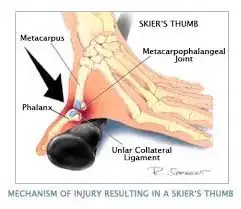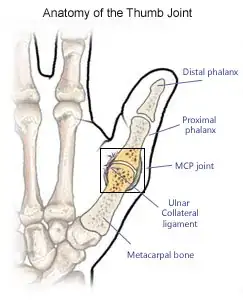"Gamekeeper's thumb" - named because of the chronic injury incurred when rabbit keepers broke rabbits' necks between the base of the thumb and index finger - has more recently been referred to as "skier's thumb", now the most common acute mechanism of the injury. If you fell on an outstretched hand hyperextending your thumb (did it feel as if the thumb was stressed beyond its normal range of motion?) and your doctor was correct, you injured the ulnar collateral ligament (UCL) of the metacarpophalangeal joint (MCPJ) of the thumb. This would cause significant pain and swelling at the base of the thumb in the "web space" between thumb and index finger.


As you can see in the picture on the right, the UCL appears partially torn. If it does not heal completely, it can result in an insufficiency of that ligament. In this case, the condition not uncommonly becomes chronic because of repeated injury to the already weakened UCL. It causes varying degrees of instability of that joint with pain and weakness of the pincer grasp (imagine squeezing an m&m between your thumb and your index finger.)
Initial treatment to optimize ligament healing is immobilization.
What can you do now? If you think you re-injured it, you can apply a cold pack (e.g. a bag of frozen peas wrapped in a dry washcloth) to the thumb as tolerated for ~20 minutes, up to four times per day.
Immobilizing the thumb with a bulky, loose ACE wrap or a commercially available thumb brace in the neutral position will help lessen the pain.
You can take acetaminophen or ibuprofen for pain relief if you have no contraindications*.
The best thing you can do is see a doctor (perhaps an orthopedist or a hand specialist would be wise), since chronic pain and instability of the thumb is not insignificant. They can do a thorough evaluation of your thumb
and either splint/cast your thumb, give you rehabilitative exercises to help you strengthen your thumb, or recommend surgery if necessary.
*Contraindication = any reason you shouldn't take it.
Always keep a cloth between your skin and the ice pack, and press firmly against all the curves of the affected area. Remove the ice pack if it causes pain, and don't fall asleep with the pack in place.
Gamekeeper's Thumb
Gamekeeper's Thumb: Wheeless' Textbook of Orthopaedics

